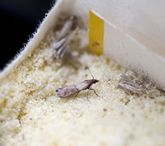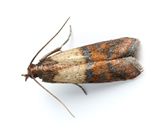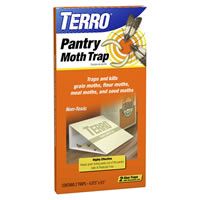Common Pantry Moth Species: Indian Meal Moths

It is common in ordinary households to experience the occasional uninvited pest. Ants, flies, spiders, stinkbugs and many other types of insects all wreak havoc on homes by causing damage to building structures and eating human and pet foods. These pests can be a severe nuisance in the home and can be very difficult to control or get rid of entirely. One such prolific pest is called the Indian meal moth, which is usually transported into the home from food purchased at the grocery store.
Indian meal moths are small winged pests that are multi-colored but primarily a pale grey color. They typically reside and reproduce indoors, primarily within food packaging in kitchens, stores selling food and industrial food processing plants. They are known to cause severe damage to food, spoiling it as it becomes infested. Indian meal moths are reported as pests in households, grocery stores and food processing companies all over the world.
Appearance
What Do Indian Meal Moths Look Like?
Indian meal moths are distinct from other moths in a few ways, though they look very similar to regular clothing moths. They have:

- A wingspan of ⅝-inch
- Pale grey wings
- Reddish brown coloring on outer wings
- Black band connecting the upper and lower hales of the wings
Indian meal moths tend to fly in a zigzag pattern. Adult moths are nocturnal, and so they become active and will fly around only at night. As a species, Indian meal moths like light and will fly toward it.
Larvae of Indian meal moths are described as:
- ½-inch long when fully grown
- Pale pink, green or yellow in coloring
- Resembling a waxworm
- Having brown heads
- Having five pairs of prolegs
- Being very active and moving relatively quickly
Look for larvae high up on walls or on ceilings as they move to these protected corners to pupate. They are so small you may need a magnifying glass to identify them.
Habitat/Diet
What Are Indian Meal Moths Attracted To?
The Indian meal moth is commonly known as the pantry moth. Unlike clothes moths, Indian meal moths damage strictly food items, not fabrics. When they make their way into homes, they set up shop in kitchen cupboards and pantries. Indian meal moths work their way into cracker and cereal boxes, bread bins, flour containers and other dried and processed goods stored in the kitchen, including pet food.
Adult females like to lay their eggs inside the dried food packages within the food itself. Once the eggs hatch, the infested food becomes contaminated and damaged by the larvae and will need to be discarded. A severe infestation of the Indian meal moth larvae can mean a lot of food will go to waste. The result is both expensive and time consuming.
Industrial Damage Caused by Indian Meal Moths
Because Indian meal moths feed on such a wide variety of dried food goods, they are considered the most common stored-food pest within the food industry. Food processing companies practice as much diligence as possible to prevent the spread of stored-food pests. However, sometimes pests do end up in packaged goods and are subsequently brought into the home.
Indian meal moths and other food pests can end up costing food processing businesses a great deal in lost revenue due to the amount of food that needs to be discarded. Food processing, distribution and retailing companies dedicate many resources to inspection and implementation of their pest control practices. The sanitization process alone is also very costly to these companies. For businesses that store and distribute food, proper sanitation practices must be implemented, especially if food storage lasts a long time.
Reproduction
Indian Meal Moth Life Cycle
Understanding the Indian meal moth life cycle is key to getting rid of them from your home. It will help you to know what signs to look for in determining whether or not you have an infestation. The adult moths invade kitchen pantries and cupboards to look for suitable food sources in which to lay their eggs.
Here is the life cycle of an Indian meal moth at a glance:
- Adult females lay up to 400 eggs within foodstuff
- Eggs hatch and produce larvae, which continue to eat and damage foodstuff
- Larvae find places to pupate in their cocoons
- Adults emerge seeking to reproduce
- Life cycle repeats
Once the female has found the right food and the right temperature, she will lay up to 400 eggs in one period. The eggs are round and white. They are microscopic and can be laid as individuals or in clusters of up to 30 eggs. Within 14 days the eggs will hatch and the larvae will emerge. The larvae will begin to spin webs made of thin silken threads to be used as protective tunnels. These webs are spun within the food, causing it to become matted and further infested, spoiling the goods.
The larvae continue to grow in size and begin feeding on fine food materials. They will keep eating until they are grown enough to begin crawling over the food and out of the packages. At this stage the larvae have become fully developed as tiny green, yellow or pink worms with brownish heads. Larvae begin to crawl up the walls toward ceilings looking for the perfect location to pupate in their cocoons.
Indian meal moth larvae reside in their cocoons for up to one month. During this stage, they do not cause any damage to the home or to food. Once the Indian meal moths have pupated, they emerge as full-grown adults. The adults then explore the home, looking for mates with which to reproduce and start the life cycle all over again. Adult Indian meal moths live for a maximum of 25 days. The entire life cycle may last anywhere from one month to five weeks, with up to six generations developing within a single year.
At this rate of reproduction, Indian meal moths can grow into a full-blown infestation in a matter of weeks, if proper precautions are not carefully taken.
Damage
Are Indian Meal Moths Harmful?
No. They are, however, still a nuisance, and the damage they cause can be extremely inconvenient and costly.
Can Indian Meal Moths Bite or Make You Sick?
No. Though Indian meal moths do not pose any serious health risks, they are a nuisance in the home. Indian meal moths do not bite and they cannot harm a person or make them sick. Rather, an Indian meal moth infestation can be an extreme annoyance to the household and can be time-consuming and costly to manage.
When an infestation occurs, all contaminated food should be discarded. Larvae contaminate the food with their silk webs and fecal deposits. These worm-like pests sneak through in the tiniest of openings. Usually the only foodstuff that’s safe are items that have been stored in a tin can, glass jar or sealed plastic container.
Control Options
How to Control Indian Meal Moth Infestations
To prevent an infestation in the first place, it is advised to inspect food packaging before purchasing it from the grocery store. Damaged or improperly sealed packaged goods shouldn’t be purchased and should be reported immediately to store staff.
If you suspect you have an Indian meal moth infestation in your home, it is advised to begin by checking all stored food in the home.
- Empty all cupboards and closets containing dried food
- Clear off all shelves and empty cupboards entirely
- Carefully examine all packaged food that is already opened or not fully sealed
- Discard all infested food and remove it from your home
- Vacuum all shelves to get rid of food crumbs and bugs, cleaning carefully in corners and between cracks and wall gaps
- Empty and clean the vacuum immediately after use to prevent the further spread of pests
- Clean cupboards and shelving surfaces with hot, soapy water or vinegar
- Seal all cracks in the walls within the cupboards
- Do a final inspection of walls and ceilings to ensure larvae aren’t hidden
- Check behind all appliances and wall hangings
Keep in mind that a very thorough cleaning of your kitchen is required. Pests can survive and continue to thrive on even the tiniest amounts of crumbs.
Salvaging Food Attacked by Indian Meal Moths
When inspecting the food, you may want to sift through it carefully to determine if there are any portions that are not contaminated. By sorting through each food item individually, you can more closely inspect for signs of damage and notice if there are any living insects or crawling larvae. If you find evidence of these, then you’ll have a better idea of where the infestation is centered.
There may be food items that you suspect could be infested, but it may be difficult to tell for certain. In this case, you can still salvage the food in question by quarantining it in a sealed glass jar or heavy-duty Ziploc bag. Keep the food under quarantine for one month. Re-inspect the food after one month and look for signs of infestation. If you find signs of pests, then it is best to discard the food immediately, again removing it from your home.
To salvage any food that is questionable, you can also choose to sanitize it. Sanitizing the food can take place by heating it or freezing it. If you choose to freeze the food, place it inside a fully sealed jar or Ziploc bag and keep it in the freezer. Ensure the temperature is at zero degrees and keep it frozen for four days to one week. If you choose to heat the questionable food, then place it in the microwave for five minutes. Otherwise you can heat it in the oven for an hour at 140 degrees Fahrenheit. Position the food so that it is spread thinly and not clumped together to ensure it is fully killing off any signs of life with the heat or cold.
Any food you are able to keep, transfer it to fully sealed plastic or tin containers. All new food brought into the home should also be transferred into sealed jars and containers to prevent a re-infestation. Alternatively, if possible, store the food in the refrigerator.
Be aware that the infestation may not have only affected human food. The infestation may also occur within pet food and bird seed. Dried plants and decorative wreaths should also be examined and discarded, if necessary.
How to Get Rid of Indian Meal Moths
If the infestation has reached a point where it cannot be controlled completely following the steps above, then there are other ways to get rid of Indian meal moths completely. Pheromone traps with sticky glue substances can be set within the kitchen and used to lure the insects to it. As adult moths become attracted to the pheromone, they approach the trap, become stuck and eventually die. This effectively ends the reproduction cycle of the Indian meal moths in the home.
Multiple pheromone traps can be set throughout the kitchen or pantry. It is recommended to position them in a variety of places. Some of the best placements include:
- Hanging traps from the ceiling near light fixtures
- Behind Appliances
- On shelving units in pantries
Aerosols and other insect sprays can be used along cracks and crevices, as well as along walls, flooring and baseboards. This will help prevent Indian meal moths from further infesting any additional food items you bring into your home. It is strongly advised not to use any form of insecticide formula or toxic spray product around food sources.
It may also be necessary or preferred to contact a pest control professional to fully complete the process. A professional will be able to identify the source of the problem and help you rid your home of the infestation.
How to Keep Indian Meal Moths Out?

To prevent the infestation of Indian meal moths in your home, follow the tips outlined above. If you experience an infestation of Indian meal moths, be sure to take every step to control the spread of these unpleasant pests. It is important to discard the contaminated food and to properly seal all future food goods in your home.
To get rid of these pests, use non-toxic TERRO® Pantry Moth Traps for Indian meal moth infestations. For best results, continue to use the traps regularly along with proper housekeeping and cleaning habits in your kitchen.
Sources:
http://www.domyownpestcontrol.com/how-to-get-rid-of-indian-meal-moths-a-251.html
http://www.planetnatural.com/pest-problem-solver/household-pests/indian-meal-moth-control/
http://ento.psu.edu/extension/factsheets/indian-meal-moth
http://entnemdept.ufl.edu/creatures/urban/stored/indianmeal_moth.htm
http://www.pestcontrolcanada.com/INSECTS/Stored%20food%20and%20fabric%20pests/indian_meal_moth.htm
http://www.doyourownpestcontrol.com/indian_meal_moth.htm
http://pestkill.org/insect/insects/indian-meal-moth/
